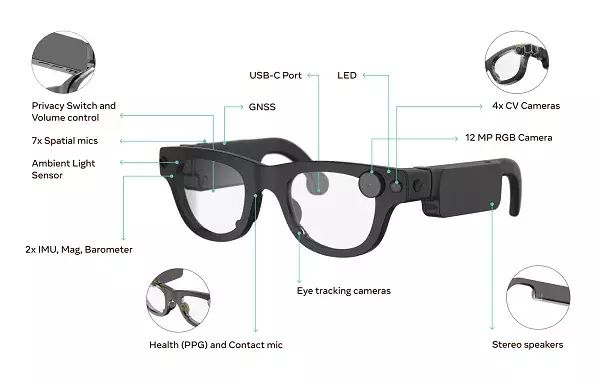In the fast-paced world of technology, Meta has kicked off a remarkable journey with its unveiling of the second-generation augmented reality (AR) glasses, dubbed “Aria Gen 2.” This isn’t a mere refresh or iteration; it represents Meta’s bold foray into changing our daily interaction with the digital realm. In a landscape where technology increasingly permeates our lives, the Aria Gen 2 stands as a potential turning point, designed to make AR a mainstream reality rather than a niche curiosity confined to tech enthusiasts.
The evolution of these glasses is nothing short of revolutionary. Meta seems intent on overcoming the typical constraints that have historically hampered AR adoption—bulky designs and hefty prices. With a weight of merely 74 to 76 grams, the Aria Gen 2 exemplifies comfort and ease, making them ideal for extended wear without causing discomfort. What’s even more striking is their aesthetic appeal; these aren’t simply gadgets but fashionable accessories that could easily blend into everyday outfits. This blurs the line between technology and personal style, challenging the old paradigm where technological functionality often came at the cost of appearance.
Beyond Novelty: Usability Comes First
Unlike conventional AR glasses, which often rely on gimmicks and superficial tech dazzlement, the Aria Gen 2 showcases Meta’s commitment to usability and practicality. These devices are outfitted with advanced capabilities like enhanced camera sensors capable of performing under various lighting conditions. This adaptability is critical for real-world applications, navigating a diverse array of environments and seamlessly merging augmented visuals with physical surroundings. The importance of a well-designed functional apparatus cannot be understated in propelling AR into the mainstream.
A noteworthy feature is the innovative contact microphone embedded in the nosepad, allowing for clear audio capture, even within noisy environments. This technology shifts the narrative from AR being merely a passive viewer experience to one where user interactions are responsive and dynamic. Alongside state-of-the-art eye and hand tracking, this creates a compelling experience where digital interactions feel as natural as tapping your smartphone screen.
The Holy Grail of Connectivity
As Meta’s CEO Mark Zuckerberg points out, this push towards functional AR glasses could very well be the “holy grail” of modern communication methods. Imagine a future where smartphones fade into the background, replaced by immersive digital overlays interacted with effortlessly through gestures. Initially, this might draw skepticism, even ridicule—a society of people talking to themselves or gesturing at nothing apparent. Still, the historical arc of technological advancement suggests a resilient adaptability on the part of society.
Consider the smartphone revolution; there was a time when mobile phones were only used for calls and texts. The same transformation could happen again, wherein our interactions with the world around us evolve as AR technology becomes second nature. The ability to manipulate virtual data overlays using just our hands is thrilling and could also usher in a paradigm shift in how we relate to technology and each other.
Collaboration as a Catalyst for Innovation
In a tactical move that signals Meta’s forward-thinking strategy, the company is planning to open applications for external developers later this year. This marks an essential paradigm shift toward a collaborative ecosystem that encourages broad innovation. By inviting third-party developers to extend the functionalities of Aria Gen 2, Meta recognizes that groundbreaking applications may not solely originate from its in-house teams.
This shared platform could unlock a wealth of diverse applications, enhancing the overall AR landscape. Think about it: the potential for pioneering educational, artistic, or business applications could flourish from this collaborative spirit. The Aria Gen 2 may transform into a canvas for digital creativity, like how apps reshaped the mobile landscape.
The Anticipation of a Transformative Future
With a retail launch slated for 2027, anticipation around the Aria Gen 2 seems palpable. As we stand at the junction of a new technological era, it’s a thrilling experience to contemplate the infinite possibilities these glasses promise to offer. The evolution from concept to consumer seems poised to unfold gradually, giving the world a front-row seat to the exciting developments awaiting us.
Meta is not just selling hardware; it’s facilitating a revolution—a compelling argument for a future in which AR is no longer a novelty but a vital part of our everyday lives. As we inch closer to this transformative reality, it’s invigorating to envision a world where augmented interactions enhance our experiences and enrich our connections with one another. Here’s to embracing the possibilities and navigating the complexities this new phase of technology brings with it.









Leave a Reply